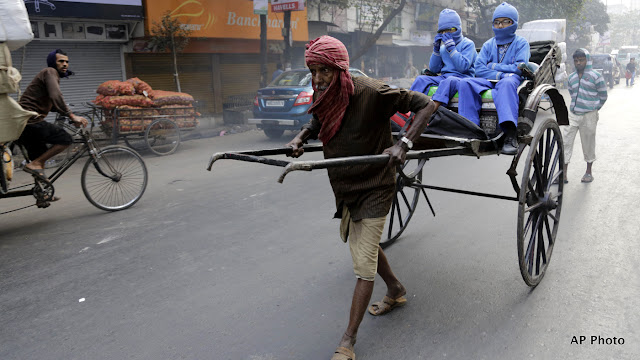THE BYGONE DAYS OF KOLKATA’S HAND-PULLED RICKSHAWS
It’s 4 in the morning. The narrow
streets of North Kolkata are still waterlogged with last night’s drizzle. It’s
not morning yet; there’s still some time for the daybreak. Faint music of Azaan
is coming from somewhere far off. The old Kolkata houses with red- oxide
floors, sleepy green-shuttered windows, intricate cornices, and elaborate
wrought-iron grills stand on one side of the road. Except for a few ‘tana’
(hand-pulled) rickshaws run by old but emaciated men, the streets are empty.
These hand-pulled rickshaws are ferrying packages to and from Burrabazar or New
Market areas.
These rickshaws offer relief in the
lanes and alleys of the old part of the city which is impassable to taxis, cars,
and autos due to waterlogging in the thick of monsoon. They keep the passengers
above the water despite their continuous hardships through the stagnant and
dirty rainwater. They are also one of the most trusted commutes for
school-going children.
Tea, tram, hand-pulled rickshaws, and
Gothic architecture are the legacies that the British have left behind. These
hand-pulled rickshaws are light-weight, wooden rickshaws pulled by men of thin
and sturdy body frame, wrapped in loincloth from the waistline till knee joint.
The rickshaw stands as a socioeconomic contrast to the modern infrastructure of
skyscrapers and flyovers. It has been over 130 years since it has been plying
the streets of Kolkata.
This model of the rickshaw was inspired by
Japan, where it was devised around the 1870s. Before its introduction, the
city’s aristocratic and highborn class, including zamindars and landlords, used
to jaunt in embellished palanquins, showing its elite socioeconomic rank.
Hand-pulled rickshaws came to be a bourgeois’ answer to palanquins. British
introduced rickshaws in Calcutta to exercise their authority and establish
their supremacy over poor Indians. This occupation of rickshaw pulling came as
a respite to the poor Indians and immigrants from Bangladesh (during Liberation
War of 1971).
However, the situation of the hand-pulled rickshaws is grimmer than is
pictured in the above lines. At present, Kolkata has 18,000 rickshaw pullers as
compared to only 6,000 rickshaws. Almost all the other countries where this
mode of transport was prevalent, are quite done with it. The battery-operated
rickshaws have now virtually replaced most of the hand-pulled rickshaws on the
streets. They truly depict the existential crisis that defines the city.
Around the year 2005, the erstwhile Left
government decided to ban these hand-pulled rickshaws claiming it to be a
perversion to human dignity. Amid discussions on this decision, the state
government led the pronouncement of Calcutta Hackney-Carriage (Amendment) Bill,
2006 and therefore, imprisoning the fate of these poor and, old rickshaw
wallahs.
The irony of this bill was the fact that in
their attempt to defend the dignity of these rickshaw wallahs, they were
instead perpetuating poverty by denying them their means of living. It provided
no kind of rehabilitation to the people who would lose their job because of
this upcoming amendment. But then this bill was thrown down the gauntlet by the
Calcutta High Court.
However,
the Kolkata Municipality issued no fresh licenses since 2005. Trinamool
Congress, the then opposition, intensely vetoed the phase-out in 2006. In fact,
its legislators boycotted the Assembly-sitting called to discuss the amendment
in the law. After TMC won the Kolkata Municipality elections in 2010, the
mayor, Sovan Chatterjee, declared that the civic body would be issuing photo ID
cards to rickshaw pullers. However, this initiative is still in process.
Although
the Mamata Banerjee government prepared a rehabilitation plan of up-gradation
of the city’s 6,000 rickshaws to battery-powered vehicles, only a little of it
got implemented. While KMC helped 5697 hand-pulled rickshaws with their
registration, and 285 pullers got listed with the Kolkata Police, Rickshaw
union claimed the number to be around 24,000 with a dependency of 1.2 lakh.
The proposal seemed to be an ideal one
when viewed through rose-colored glasses. But now being in 2019, when glanced
down the time frame, it appears that things did not work out well as they were
supposed to. The e-rickshaws were introduced not as an alternative for the
rickshaw pullers but as an extra burden to their lives. Not all rickshaw
pullers got the advantage of the government scheme, and many could not afford
to upgrade to e-rickshaws without governmental subsidy.
Moreover, many old rickshaw pullers do
not have the resource to do anything else other than bearing and pulling the
weight, double (sometimes triple) of their own, soring the veins making it
visible and glaring through the dark, perspiring skin, scorched under prolonged
exposure to the sun.
The costs
of operation of these rickshaws, their size and, the cost of vehicles are high
when compared to the amount they charge for every ride. They also seem to have
tickled media and photographers' fancy.
It is
very remorseful to watch people having simpering nostalgia over this inhumanity
and cruelty that once served the British propaganda of elitism but now is out
of place in this modern-day democracy. But, call it fate or life, these
hand-pulled rickshaw wallahs became the unfortunate victims of a false heritage
that feeds our pride.


Nostalgia!
ReplyDelete